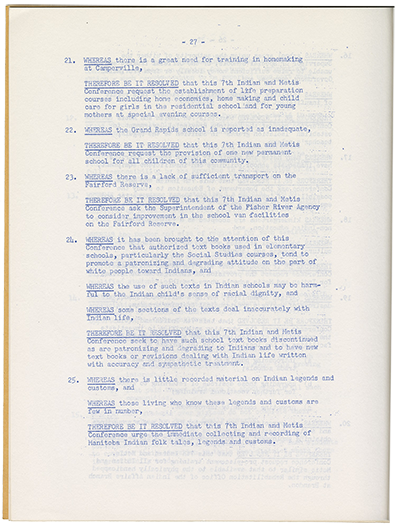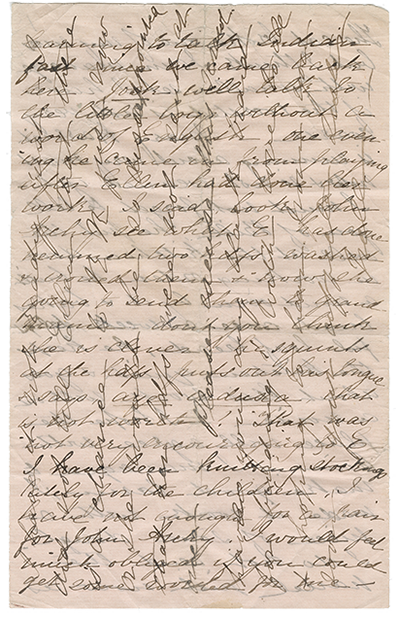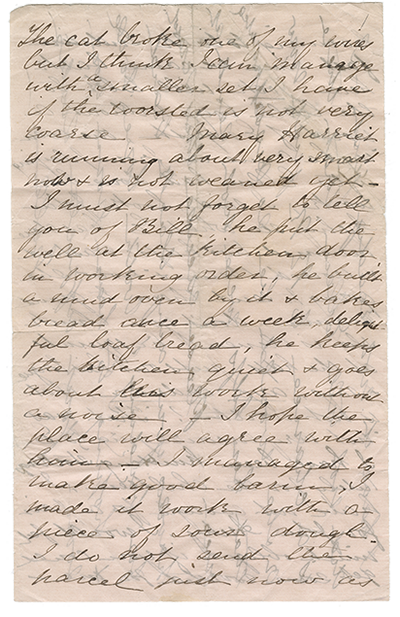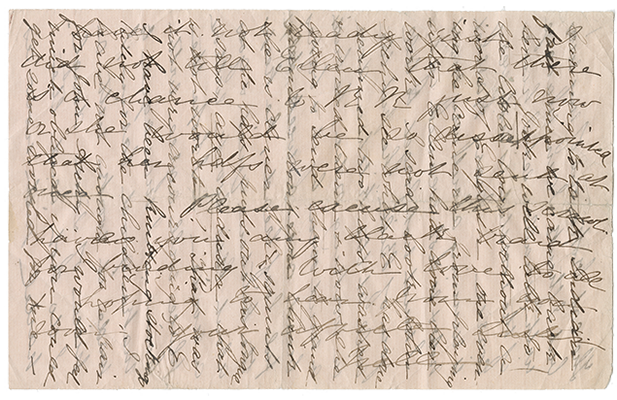Visit this blog for regular posts about Your Archives: The Histories We Share. Visit the Archives of Manitoba to see the records in person.
October 2020:
- October 30, 2020: Double exposed photograph in James McDougall fonds — Submission by Mandy Malazdrewich, Archivist, Hudson’s Bay Company Archives, Archives of Manitoba
- October 23, 2020: Women’s Musical Club of Winnipeg fonds — Submission by Dr. Kathryn A. Young, Ph.D History, Historian and former board member of the Women's Musical Club of Winnipeg
- October 16, 2020: "My Notebook" by Isobel G. Finlayson. This is the chronicle of Isobel's 1840 journey on the “Prince Rupert” from London to York Factory, and from there to the Red River Settlement — Submitted by Heather Beattie, Archivist
- October 9, 2020: Resolution found in proceedings booklet for the 7th Annual Indian and Metis Conference — Dr. Mary Jane McCallum, Professor of History, University of Winnipeg
- October 2, 2020: Inkster family correspondence (1853-1895) — Samantha Booth, Archivist, Hudson’s Bay Company Archives
October 30, 2020
Double exposed photograph in James McDougall fonds — Submission by Mandy Malazdrewich, Archivist, Hudson’s Bay Company Archives, Archives of Manitoba
“As a person interested in photographs and photographic processes I’m drawn to this image because on the surface it seems to be a technical mistake, and at the same time it is quite beautiful. The ‘mistake’ of this image draws attention to its construction and allows the viewer into the process of making. The details of this photograph help to reveal this photographer’s approach; the cumbersome equipment that he must have travelled with, the difficult and time-consuming process of taking an exposure, how easy it would have been to double-expose a negative. Did the photographer consider this image a failure? Why has it survived?
![double exposure, one of post, one of four men and loaded canoe], ca. 1889, H4-197-4-1](../../images/2020/2020-10-30_sm_01.png)
enlarge image
full size
“I first saw this image as part of the James McDougall fonds when I was on a short-term internship at the Hudson’s Bay Company Archives in the middle of my degree in Photographic Preservation and Collections Management. I was intrigued by the paper negatives and amazed that the archives holds both the negatives and the corresponding prints that James McDougall presumably made for a personal album. The sheer size of the collection and the geographic distance that the photographs cover is also impressive. Then, to top it all off, the Hudson’s Bay Company Archives holds personal records for McDougall as well as many corporate records that he created while working for the HBC on the inspecting trips when he was taking these photographs. What a rich opportunity to learn about the photographer and his process alongside his work with the Hudson’s Bay Company.”
Want to know more? Search Keystone for more information. You can also Visit Us in person at the Archives of Manitoba.
Want to participate in Your Archives? See Submit Your Story for details. You may e-mail us at yourarchives@gov.mb.ca with a comment about this blog post and your comments may be included on this page.
October 23, 2020
Women’s Musical Club of Winnipeg fonds — Submission by Dr. Kathryn A. Young, Ph.D History, Historian and former board member of the Women's Musical Club of Winnipeg
“In 1894 a small group of Winnipeg women gathered in a home near the forks of the Red and Assiniboine Rivers. Their goal was to bring classical music into their community in those days of settlement of the Canadian West. A year earlier, Quebec women had established the Ladies Morning Musical Club of Montreal and somewhat later, in 1898, Ontario women came together to begin the Women’s Musical Club of Toronto. Before the turn of the century, the Winnipeg women and their musical friends performed in their homes but by 1906 they were bringing in artists from New York, Boston, London and Paris who were travelling the international concert circuit. That year, the Club sponsored Madame Fanny Bloomfield Zeisler, ‘[o]ne of the world’s greatest pianists’ and, in 1910, Nellie Melba, the renowned Australian operatic soprano.
“Throughout its long history the Women’s Musical Club of Winnipeg (WMC) has presented a concert series and offered scholarships to up and coming young musicians. Since its inception the women of this volunteer organization have charted their history in a range of documents now conserved in the Archives of Manitoba. Correspondence, minute books, scrapbooks, newspaper clippings, photographs, press releases and autograph books make up the collection.
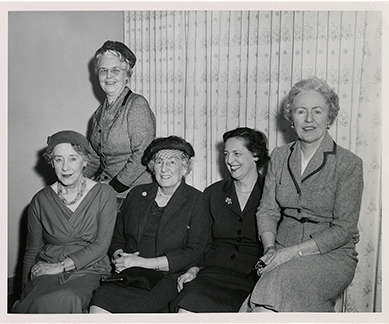
enlarge image
full size
Archives of Manitoba, Women’s Musical Club of Winnipeg fonds, Women’s Musical Club photograph 1, [196-?], P8088/3.
“In recent years, Board members of the WMC have had the privilege to gather in the Archives of Manitoba Reading Room for a morning of classical music nostalgia. Their excitement and enthusiasm has been electric as they were transported back in time by scrapbooks, programs and photographs featuring, for instance: Miss Amelita Galli-Curci, soprano (1920-21), Glenn Gould, piano (1954-55), Maureen Forrester, soprano (1956-57), Teresa Stratas, soprano (1963-64), Mistislov Rastroprovich, violincello (1971-72), Marc-André Hamelin, piano (1999-2000), Tracy Dahl, soprano (2001-02) and James Ehnes, violin (2015) for WMC’s 120th Anniversary Celebration.
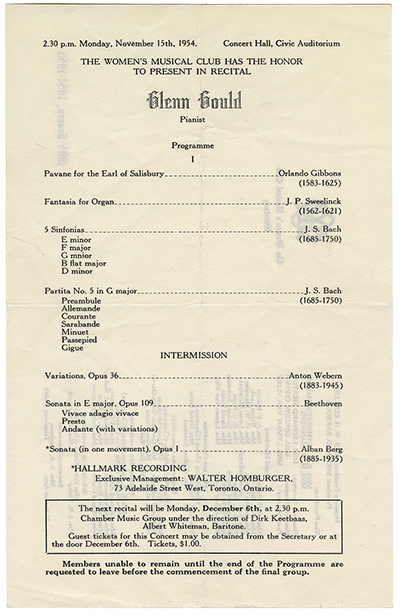
enlarge image
full size
“The collection is a rich and valuable resource for Winnipeg’s musical history. It is well catalogued and easily accessible. For overviews of the Club’s history, see: Kathryn A. Young, ‘With Every Note Played:’ A History of the Women’s Musical Club of Winnipeg, 1894-2014 (Winnipeg: Rinella Printers, 2014) and Valorie Dyck, ‘Let Us Enjoy Music:’ A History of the Women’s Musical Club of Winnipeg, 1894-1994 (Winnipeg: Rinella Printers, 1994).
“Students in the School of Music, music historians, and classical music buffs will be interested in this fonds, as will historians and sociologists of the City of Winnipeg.”
Want to know more? Search Keystone for more information. You can also Visit Us in person at the Archives of Manitoba.
Want to participate in Your Archives? See Submit Your Story for details. You may e-mail us at yourarchives@gov.mb.ca with a comment about this blog post and your comments may be included on this page.
October 16, 2020
"My Notebook" by Isobel G. Finlayson. This is the chronicle of Isobel's 1840 journey on the “Prince Rupert” from London to York Factory, and from there to the Red River Settlement — Submitted by Heather Beattie, Archivist
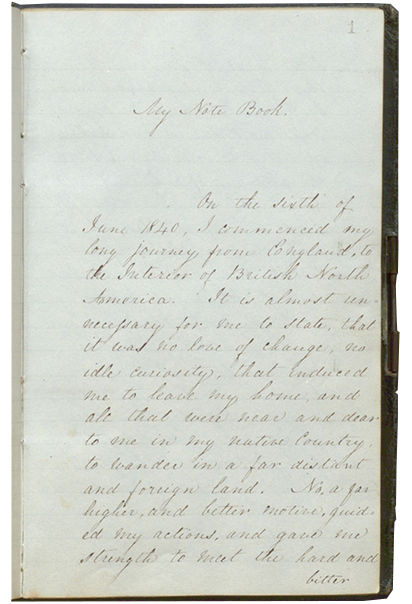
enlarge image
full size
Hudson’s Bay Company Archives, Archives of Manitoba, Duncan and Isobel Finlayson fonds, “My Notebook” by Isobel G. Finlayson, 1840, E.12/5 (H2-136-3-4).
“I have a long-standing interest in women's diaries and travel writing, and this record stands out for a number of reasons. The vast majority of the records in the Hudson's Bay Company Archives holdings were created by men for business purposes, so a personal account written by a woman provides a very different perspective of the same time and place. The notebook includes several pencil drawings of people and scenes Isobel Finlayson encountered during her journey, which help bring her words to life.
!["Front Gate, Fort Garry" [Upper Fort Garry]](../../images/2020/2020-10-16_sm_02.png)
enlarge image
full size
HBCA, E.12/5 fo. 85 (N4843)
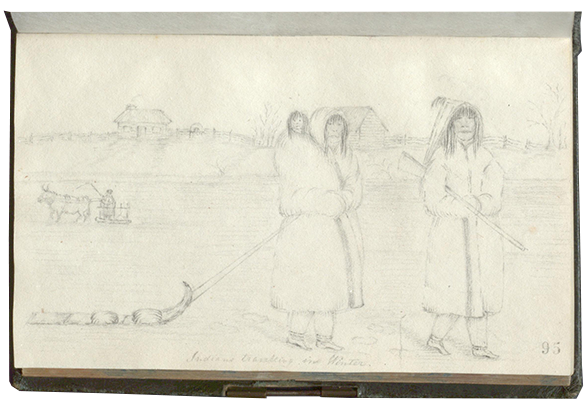
enlarge image
full size
HBCA, E.12/5 fo. 95 (N5575)
“Isobel Finlayson was married to Duncan Finlayson, a Hudson's Bay Company chief factor and governor of Assiniboia. She was also the sister of Frances Simpson, wife of HBC Governor George Simpson. It's both uncomfortable and fascinating to read the description of her voyage to the Red River Settlement and realize how extremely difficult it must have been, even though she had it far easier than the vast majority of people making that trip. Isobel provides many details of day-to-day life that were rarely described in official HBC records. This is interesting and valuable, as is what Isobel's writing tells us about her ideologies of gender, race, class, and progress.”
Want to know more? This record has been digitized and is available on Keystone. Search Keystone for other records related to Isobel and Duncan Finlayson, Frances and George Simpson, and the Red River Settlement. You can also Visit Us in person at the Archives of Manitoba.
Want to participate in Your Archives? See Submit Your Story for details. You may e-mail us at yourarchives@gov.mb.ca with a comment about this blog post and your comments may be included on this page.
October 9, 2020
Resolution found in proceedings booklet for the 7th Annual Indian and Metis Conference — Dr. Mary Jane McCallum, Professor of History, University of Winnipeg
“WHEREAS it has been brought to the attention of this Conference that authorized text books used in elementary schools, particularly the Social Studies courses, tend to promote a patronizing and degrading attitude on the part of white people toward Indians, and
“WHEREAS the use of such texts in Indian schools may be harmful to the Indian child’s sense of racial dignity, and
“WHEREAS sections of the texts deal inaccurately with Indian life,
“THEREFORE BE IT RESOLVED that this 7th Indian and Metis Conference seek to have such school text books discontinued as are patronizing and degrading to Indians and to have new textbooks or revisions dealing with Indian life written with accuracy and sympathetic treatment.”
“This resolution to remove school textbooks that ‘promote a patronizing and degrading attitude toward Indians’ from elementary schools was originated at the 7th Annual Indian and Metis Conference of the Welfare Council of Greater Winnipeg, held February 21-24, 1961 and is contained in ‘Partners In Planning,’ a Conference proceedings booklet preserved within the Beatrice Brigden fonds at the Archives of Manitoba.
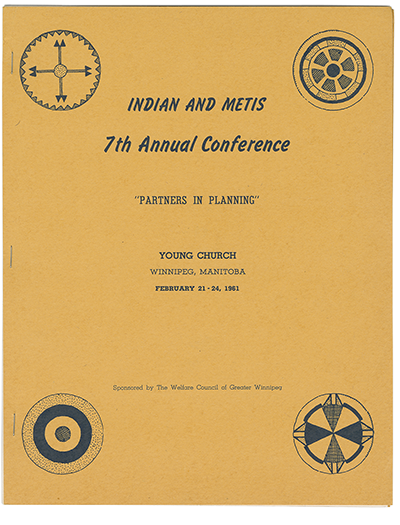
enlarge image
full size
“’MB 150’ is in part about reflecting on the past and taking stock. As a historian, I am interested in how the past is represented and whose history is counted. This 1961 resolution to document and challenge racism in elementary textbooks is one small piece of a history of calls for reforms in public education to improve curricular content about Indigenous people and Indigenous history. The resolution led to a study on Manitoba school textbooks by the Indian and Metis Committee of the Welfare Council that was presented to the Curriculum Revision Committee of Manitoba’s Department of Education in 1964. The study was ‘A Survey of Canadian History Textbooks now in use in Manitoba schools in order to determine to what extent they tend to promote a degrading attitude on the part of white people toward Indians, are harmful to the Indian Child's sense of racial dignity and deal inaccurately with Indian Life.’ Further review by the Manitoba Indian Brotherhood resulted in the book The Shocking Truth about Indians in Textbooks! (1974) adding pressure on the Department of Education to cull racist textbooks from the elementary school curriculum. Celebrated Manitoba Cree educator Verna Kirkness was central to these efforts.1
“I chose this record because we still encounter misrepresentations in the way Manitoba history is told, and work to challenge and change them is ongoing.2 One of the most common, as identified by the Indian and Metis Committee, is the ‘error of omission’: that is, when textbooks simply omit the imperatives, governance, laws, voices, and actions of Indigenous peoples. A recent example of errors of omission is Premier Brian Pallister’s carefully worded Statement on Manitoba’s 150th Anniversary, which, in a rendering of Manitoba as a ‘welcoming, safe, and prosperous place,’ fails to mention Indigenous people at all. Locating Manitoba’s history firmly in the time since 1871 and focusing on the contributions and experiences of subsequent waves of newcomers obscures the long history of Indigenous presence, cooperation and treaty that made Manitoba possible.3
“I also chose this record because of its location in the Beatrice Brigden fonds. Brigden was a white, Methodist Canadian reformer, feminist, and socialist. While we may not expect to find the voices and knowledge of Indigenous people in private collections of individuals like Brigden, we can and we do. Brigden worked for a time with the Welfare Council of Greater Winnipeg, and through that work she attended meetings of Indigenous organizations in the 1960s and 1970s. She tended to collect ‘everyday’ records of these organizations, including flyers, pamphlets, newsletters and agendas – material that, because it was so mundane, was rarely kept, stored, or archived and can be difficult to find. In conjunction with other collections at the Archives of Manitoba and elsewhere, including the Department of Education, the Indian and Metis Friendship Centre, the City of Winnipeg Archives, the archives of the Universities of Winnipeg and Manitoba, and Library and Archives Canada, it is possible to gain valuable perspectives of Indigenous people about life in Winnipeg in the 1960s that help broaden our understanding of the past and improve our responses to community needs and relationships today.”
References:
- ^ Manitoba Indian Brotherhood, The Shocking Truth About Indians in Textbooks! 1974. Reprint. Winnipeg: Manitoba Indigenous Cultural Education Centre Inc., 2016; and Verna Kirkness, Creating Space: My Life and Work in Indigenous Education. Winnipeg: University of Manitoba Press, 2013.
- ^ The 10th Call To Action of the Truth And Reconciliation Commission outlined the need for new legislation and funding to develop culturally appropriate curricula. Truth and Reconciliation Commission of Canada, Final Report of the Truth and Reconciliation Commission of Canada: Calls To Action. Winnipeg: Truth and Reconciliation Commission of Canada, 2015. At http://trc.ca/assets/pdf/Calls_to_Action_English2.pdf (Accessed 18 August, 2020). There is also ongoing resistance to accepting new historical facts and interpretations enabled by new sources and new methodologies and approaches, resistance that is often rooted in lessons learned from those old textbooks. See Trevor Gulliver and Kristy Thurrell, “Denials of Racism in Canadian English Language Textbooks,” TESL Canada Journal 33 (2017): 42-61; and Philip Lee-Shanok, “GTA book publisher accused of whitewashing Indigenous history” CBC News, October 3, 2017 https://www.cbc.ca/news/canada/toronto/childrens-textbook-includes-inaccurate-account-of-indigenous-history-1.4315945 (Accessed 18 August, 2020).
- ^ The full Statement on Manitoba’s 150th Anniversary can be found here: https://news.gov.mb.ca/news/index.html?item=48097&posted=2020-05-12 (Accessed 18 August, 2020).
Want to know more? Search Keystone for more information. You can also Visit Us in person at the Archives of Manitoba.
Want to participate in Your Archives? See Submit Your Story for details. You may e-mail us at yourarchives@gov.mb.ca with a comment about this blog post and your comments may be included on this page.
October 2, 2020
Inkster family correspondence (1853-1895) — Samantha Booth, Archivist, Hudson’s Bay Company Archives
“The records I would like to highlight are the Inkster family correspondence in the William and Harriet McMurray fonds. This collection of correspondence was maintained and eventually donated to the Hudson’s Bay Company Archives by the McMurrays' granddaughter Nancy McGowan and contains letters to and from largely the women of the Inkster family, a prominent Métis family in the fur trade of the late 19th and early 20th centuries. The Inkster family was established in what became Canada by John Inkster (1799-1874), a Hudson’s Bay Company (HBC) employee and later Red River settler from Orkney, and Mary Sinclair (1805-1892), daughter of HBC chief factor William Sinclair and Margaret (Nahoway), a woman of Omushkego (Swampy Cree) and English descent. Their family home, Seven Oaks House, is now a museum in Winnipeg. Harriet Inkster McMurray was one of their nine children.
“This particular (incomplete) letter was written around 1870 by Ellen (Nell) Inkster McDonald, Harriet Inkster McMurray’s sister and wife of HBC employee Archibald McDonald. It discusses various aspects of the McDonald family’s recent move to the HBC post at Fort Qu’Appelle, including the kitchen facilities and baking bread, the children making friends and learning a new Indigenous language, the cat breaking a knitting needle, and a request for more worsted wool to knit socks. This letter also illustrates the custom of “crossing” or “cross-lining”, where the correspondent writes on top of a previously inscribed page to save paper. This habit was more prevalent among women, according to an 1876 style guide. I encourage all of you to try your hand at transcribing the cross-lining, and then check my transcription!
“I came across these records as part of a project to redescribe the McMurray family fonds, and was so taken by them that I also recommended that this letter be part of the display for HBCA tours, and it is currently on display in the HBCA visual vault. I find these records so interesting as they provide such a human, and especially feminine, dimension to the study of the fur trade in Manitoba and on the prairies more broadly. Records such as this, documenting daily life and customs, are especially interesting and rare within the Hudson's Bay Company Archives, as HBC notoriously did not record almost any information about employees' families, like women and children, or what their lives might have been like at HBC posts. And records such as these really highlight just how much the history of the Hudson's Bay Company is in fact Indigenous history – particularly Métis history, in Manitoba.”
The following is a transcription of the letter, prepared by Samantha Booth:
“…learning to talk Indian fast since we came back here. Jock will talk to the little boys without a word of English & one evening he came in from playing after Ellen had done her work, I said look John Archy see what E has done, hemmed two h…s [halfs?], washed & ironed them & now she going to send them to grandmama, don't you think she is clever? He squints at the [halfs?], puts out his tongue and says, aye [indusca? ardusca?], that is not worth? That was not very encouraging to E – I have been knitting stockings lately for the children, I have not enough for a pair for John Archy. I would feel much obliged if you could get some worsted for me –
“the cat broke one of my wires [needles] but I think I can manage with a smaller set I have if the worsted is not very coarse – Mary Harriet is running about very smart now & is not weaned yet – I must not forget to tell you of Bill, he put the well at the kitchen door in working order, he built a mud oven by it & bakes bread once a week, delightful loaf bread, he keeps the kitchen quiet & goes about this work without a noise – I hope the place will agree with him – I managed to make good bar.. [???], I made it work with a piece of sour dough. I do not send the parcel just now as
“I have it not ready just – I did not tell Ellen that there is a chance to RR [? For Red River?] just now or she would be so disappointed that her [halfs?] were not sent at once – Please excuse this .era..[???] have[?] you any black braid for binding? with love to all & hoping to hear from you soon, your affect[ionat]e sister, Nell”
Hudsonís Bay Company Archives, Archives of Manitoba, William and Harriet McMurray family fonds, Inkster family correspondence, 1853-1895, HBCA E.61/35 fo. 1-1d. See Keystone description here.
Want to know more? Search Keystone for other records related to the Red River Settlement, the Inkster family, and the McMurray family. You can also Visit Us in person at the Archives of Manitoba.
Want to participate in Your Archives? See Submit Your Story for details. You may e-mail us at yourarchives@gov.mb.ca with a comment about this blog post and your comments may be included on this page.



